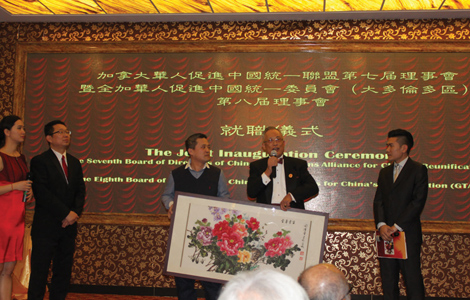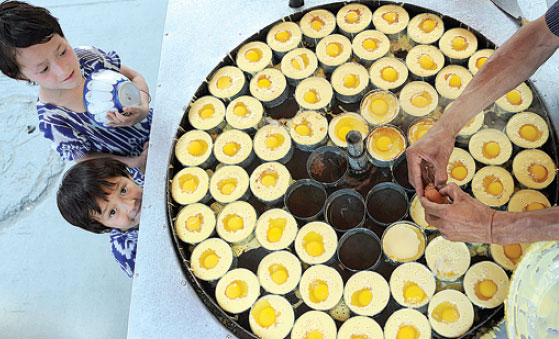The heart of Xinjiang cuisine
Updated: 2015-01-22 07:13
By Yang Feiyue(China Daily USA)
|
||||||||
The diet in the Xinjiang Uygur autonomous region is characteristic of Muslim food and also inherits the relatively strong taste of foods in northwestern China. Most Xinjiang dishes taste tangy and spicy, and are made of beef and mutton cuts that are stir fried, roasted, steamed or made by other cooking methods.
The inland climate, with little rainwater and vast desert, rule seafood out of court in Xinjiang, but the region has abundant resources of cattle and sheep.
Uygur meals are largely based on mutton, beef, chicken, goose, carrots, tomatoes, onions, peppers, eggplant, celery, various dairy foods and fruits. A typical breakfast usually includes home-baked bread (naan), firm but smooth yogurt, olives, raisins and almonds, all washed down with tea.
Cumin seeds, red pepper flakes, salt and black pepper are most frequently used in preparing Xinjiang food.
Xinjiang food began taking roots in China when Islam made inroads into the country. The ethnic groups of the region all have their own food prohibitions and features. Generally speaking, pork is strictly forbidden on the dining table.
Uygur people like to treat guests with tea, naan and fruits before the main dishes are served. Most Uygur foods are eaten with chopsticks, a custom that has been adopted from Han Chinese culture since the 19th century. Other ethnic groups in Xinjiang generally have varied cooking and eating methods: Kazakhs there, for example, usually eat with their hands.
Uygur hosts like to lay out a tablecloth before dining, and it's not considered good form to leave food or put food back from their plates. Most of them don't eat dove and horse meat, and soy sauce is not much used.
Hui ethnic people don't eat meat that comes from animals killed by non-Muslims or consume animal blood. Jokes about food are also frowned upon.
Xinjiang cuisine can be found across China; many locals have migrated to other cities to run Xinjiang restaurants or food stands, which has helped to popularize the distinctive cuisine around the country.
|
Two children wait at a street-food stand in Kashgar, Xinjiang Uygur autonomous region. Zhang Yi / For China Daily |
(China Daily USA 01/22/2015 page7)

 Across Canada Jan 21
Across Canada Jan 21
 Wuhan to get green center done by US firm
Wuhan to get green center done by US firm
 What Obama proposes in State of the Union Address
What Obama proposes in State of the Union Address
 Cuba, US ready for historic talks on restoring ties
Cuba, US ready for historic talks on restoring ties
 Doctor shot inside a Boston hospital
Doctor shot inside a Boston hospital
 US firm designing green center in China
US firm designing green center in China
 Forbidden City orchestra to play Houston
Forbidden City orchestra to play Houston
 Chinese premier arrives in Switzerland for Davos forum, working visit
Chinese premier arrives in Switzerland for Davos forum, working visit
Most Viewed
Editor's Picks

|

|

|

|

|

|
Today's Top News
Ontario highlighted in China’s high-level overseas investment forum
Stampede victims' families compensated
Oil-price drop spurs Chinese to invest in Texas
IMF's China outlook to affect others
Obama seeks backing of force on ISIS
Wuhan to get green center done by US firm
Chinese orchestra to play Houston
Chinese students launch massive online course
US Weekly

|

|








